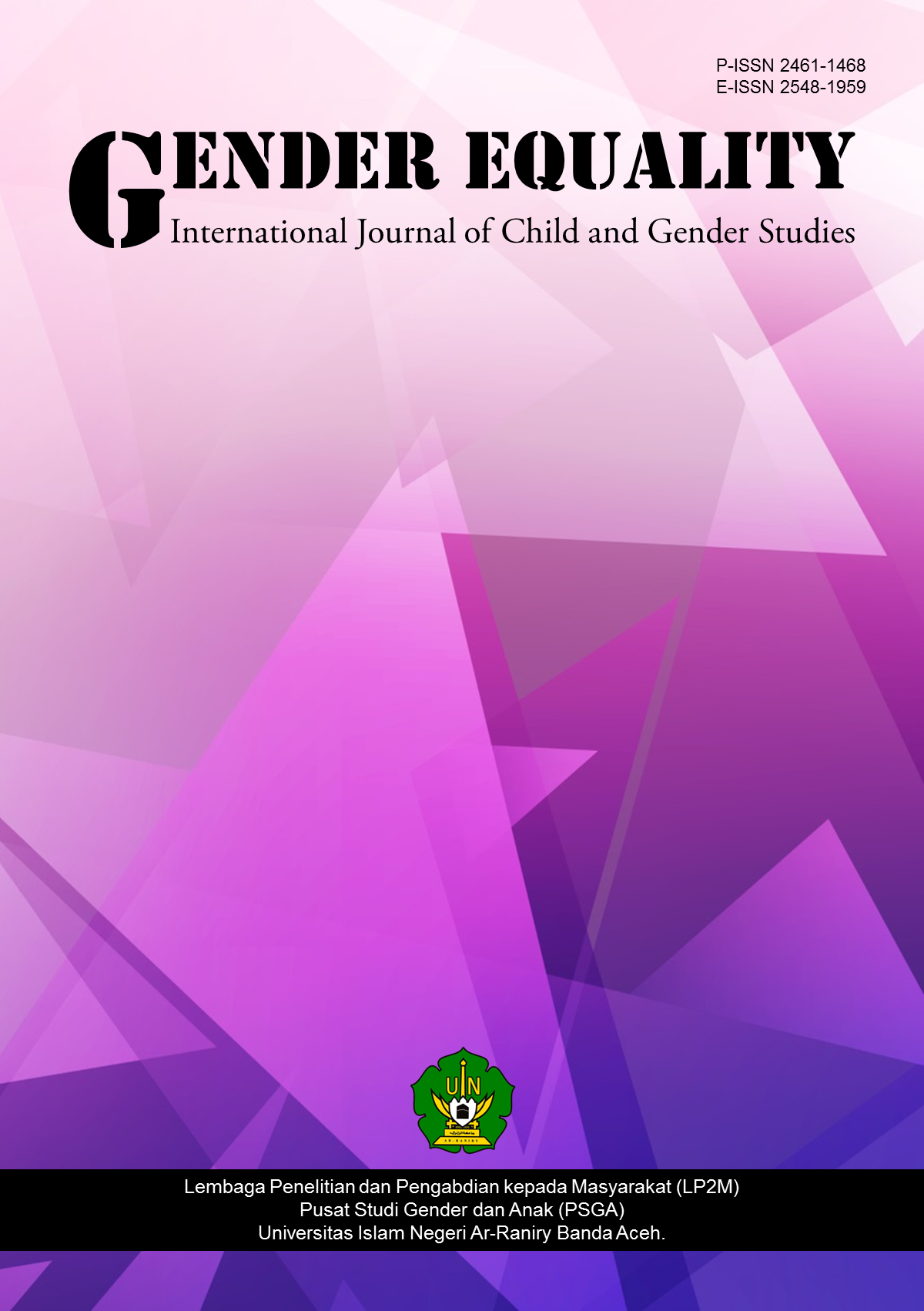Gender equality in the Qur’an: An Analysis of surah an-Nisa’ verses 1 and 34 in the exegesis of al-Tabari and al-Rāzī
DOI:
https://doi.org/10.22373/equality.v10i2.25932Keywords:
Justice, Gender, Surah An-Nisa' Verses 1 and 34, Al-Ṭabarī, Al-RāzīAbstract
Surah An-Nisa' verses 1 and 34 have been central to discussions on gender. According to the interpretations of Imam al-Ṭabarī and Imam al-Rāzī, these verses place women in a subordinate role, both in domestic and non-domestic spheres. This interpretation is considered biased, not reflecting the true essence of the Qur'an. Therefore, further research is necessary to uncover the Qur'an’s intended view on gender in these verses. The study uses a descriptive-analytical method with a qualitative approach, gathering data from books, theses, and articles. The findings reveal that al-Ṭabarī and al-Rāzī's interpretations reinforce male superiority in patriarchal tradition, stating that Eve was created from Adam's rib and that the husband is the absolute leader of the wife. However, contemporary scholars argue that interpreting "nafs" as referring to the unity of humanity without any connotation of gender superiority, emphasizing equality in Islam. The Qur'an advocates for justice in gender issues, making traditional interpretations obsolete in today's context. Regarding Surah An-Nisa' verse 34, al-Ṭabarī and al-Rāzī interpreted men as the rightful leaders over their wives due to the advantages given by Allah, with financial responsibility as the foundation of their authority. However, modern-contemporary tafsir scholars reject this view, interpreting qiwāmah as shared responsibility regardless of gender, emphasizing partnership in the household and gender equality in Islam. This reflects efforts to understand Qur'anic verses contextually and inclusively, supporting the principles of equality and justice.
References
Abdul-Baqi, M. F. (2022). Tafsir al-Mazhariy (Jilid I). Riyadh: Dar al-Talib.
Abdullah, Z. H., & Ramadhan, S. (2023). Isu-Isu Gender Sebagai Basis Pemikiran Modern-Kontemporer Pemikiran Dalam Islam. Religion: Jurnal Agama, Sosial, dan Budaya, 1(2), 515–524.
Ahmed, L. (1992). Women and Gender in Islam: Historical Roots of a Modern Debate. New Haven, CT: Yale University Press.
Al-Farra’, A. Z. Y. I. Z. (1989). Ma´ani Al-Qur’ān (Jilid I). Beirut: Muassasah al-Azhar.
Al-Jassas, A. ibn M. (2005). Ahkam al-Qur’an (Jilid II). Beirut: Dar al-Kutub al-`Ilmiyyah.
Al-Khuli, M. (2021). The History of Tafsir: A Chronological Study. Cairo: Islamic Research Institute.
Al-Qurtubi, M. ibn A. (2006). Al-Jami’ li Ahkam al-Qur’an (Jilid V). Beirut: Dar al-Kutub al-`Ilmiyyah.
Al-Rāzī, F. (1981). Mafātīh al-Ghaīb (Jilid IX). Beirut: Dar al-Fikr.
Al-Rāzī, F. (1981). Mafātīh al-Ghaīb (Jilid X). Beirut: Dar al-Fikr.
Al-Ṭabarī, A. J. M. bin J. I. (1999). Jāmi´ al-Bayān fī Tafsīr Ay Al-Qur’ān (Jilid VII). Beirut: Dar al-Kutub al-`Ilmiyyah.
Al-Ṭabarī, A. J. M. bin J. I. (1999). Jāmi´ al-Bayān fī Tafsīr Ay Al-Qur’ān (Jilid VIII). Beirut: Dar al-Kutub al-`Ilmiyyah.
Anam, H. F. (2019). Tafsir Feminisme Islam. Maghza: Jurnal Ilmu Al-Qur’an dan Tafsir, 4(2), 161–176. https://doi.org/10.24090/maghza.v4i2.3071
Aziz, N. (2012). Penafsiran Al-Qur’an Kontemporer Metode Penafsiran Bintu Syathi’ dan Fazlur Rahman. Banda Aceh: Ar-Raniry Press.
Barlas, A. (2003). Believing Women in Islam: Unreading Patriarchal Interpretations of The Qur’an. London: University of Oxford.
Fakih, M. (2000). Membincang Gender Perspektif Islam. Surabaya: Risalah Gusti.
Hassan, R., & Mernissi, F. (1995). Setara di Hadapan Allah, Relasi Laki-laki dan Perempuan dalam Tradisi Islam Pasca Patriarkhi. Yogyakarta: Yayasan Prakarsa.
Hermawati, I. R. (2013). Relasi Gender. Yogyakarta: Pustaka Pelajar.
Kodir, F. A. (2019). Qiraah Mubadalah: Tafsir Progresif untuk Keadilan Gender dalam Islam. Yogyakarta: IRCiSoD.
Lemu, A. (2023). Understanding the Qur’an: A Historical and Contextual Approach. Oxford: Oxford University Press.
Mansour, F. (1996). Analisis Gender dan Transformasi Sosial. Yogyakarta: Pustaka Pelajar. 7-8.
Mir-Hosseini, Z. (1999). Feminism and Islam: Legal and Literary Perspectives. London: I.B. Tauris.
Muhammad, K. H. (2001). Fiqh Perempuan: Refleksi Kiai atas Wacana Agama dan Gender. LKIS Pelangi Aksara.
Mulia, S. M. (2007). Islam dan Inspirasi Kesetaraan Gender. Yogyakarta: Kibar Press.
Mulia, S. M. (2011). Muslimah Sejati: Menempuh Jalan Islami Meraih Ridha Ilahi. Bandung: Marja.
Mustabsyirah. et.al (2009). Tafsir: Buku Daras Berperspektif Gender. Banda Aceh: PSW IAIN Ar-Raniry.
Nazir, M. (2003). Metode Penelitian (cet V). Jakarta: Ghalia Indonesia.
Rifâ, D. F., & Nurwahidin, N. (2022). Feminisme Dan Kesetaraan Gender Dalam Kajian Islam Kontemporer. Syntax Literate; Jurnal Ilmiah Indonesia, 7(1), 172-182. https://jurnal.syntaxliterate.co.id/index.php/syntax-literate/article/view/6038
Subhan, Z. (1999). Tafsir Kebencian: Studi Bias Gender dalam Tafsir Al-Qur’an. Yogyakarta: LKiS.
Subhan, Z. (2015). Al-Qur’an & Perempuan. Jakarta: Prenada Media Group.
Swallow, J. (2023). The Butterfly Effect: How Small Things Can Make a Big Difference. London: Penguin Books.
Umar, N. (2001). Argumentasi Kesetaraan Gender Perspektif Al-Qur’an. Jakarta: Paramadina.
Wadud, A. (2001). Quran Menurut Perempuan: Meluruskan Bias Gender Dalam Tradisi Tafsir. Jakarta: Serambi Ilmu Semesta.
Downloads
Published
Issue
Section
License
GENDER EQUALITY: International Journal of Child and Gender Studies allows the author(s) to hold the copyright and to retain the publishing rights without restrictions. Authors who publish with this journal agree to the following terms:
- Authors retain copyright and grant the journal right of first publication with the work simultaneously licensed under a Creative Commons Attribution License that allows others to share the work with an acknowledgment of the work's authorship and initial publication in this journal.
- Authors are able to enter into separate, additional contractual arrangements for the non-exclusive distribution of the journal's published version of the work (e.g., post it to an institutional repository or publish it in a book), with an acknowledgment of its initial publication in this journal.
- Authors are permitted and encouraged to post their work online (e.g., in institutional repositories or on their website) prior to and during the submission process, as it can lead to productive exchanges, as well as earlier and greater citation of published work.



